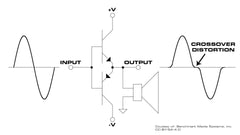Buy one component and save 10% on up to 2 cables. Buy 2 components and get 4 free cables. Free shipping on USA orders over $700.
Buy one component and save 10% on up to 2 cables. Buy 2 components and get 4 free cables. Free shipping on USA orders over $700.
AHB2 Crossover Distortion Measurements
by John Siau March 10, 2016

AHB2 Measurements
The following measurements and scope photos demonstrate the effectiveness of the feedforward system in the AHB2. From the first Watt to the last Watt, the AHB2 shows no evidence of crossover distortion. In contrast, all conventional class-AB amplifiers have crossover-distortion artifacts.
Dick Olsher once said that "the first Watt is the most important Watt". We agree!
In most listening situations, an amplifier spends most of its time near the 1-Watt output level. At these low levels, push-pull crossover distortion can be the dominant type of distortion. This non-musical distortion must be minimized or eliminated. Until the AHB2 was introduced, the only solution was class-A operation.
Now everything has changed. The patented feedforward error correction system in the AHB2 offers a better alternative to class-A amplifiers. The AHB2 exceeds the performance of all class-A power amplifiers, and it does so without generating the massive amount of heat produced by class-A amplifiers. The AHB2 is nearly as efficient as a class-D amplifier, but it outperforms all class-A amplifiers. This is why we say that the AHB2 is "the cleanest, quietest amplifier on the planet".
THD+N
The 1-Watt THD+N measurements demonstrate that the AHB2 is free from any crossover distortion. Note that the AHB2 also stays clean at 1/3 power and at its full rated output power. Also note that there is almost no measurable difference between 8-Ohm and 4-Ohm loading. The same holds true for bridged-mono operation.
THD+N at 1 kHz into 8-Ohms, 22 kHz BW:
-108dB (0.0004%) at 1 W (1 W is -20 dB relative to rated power)
-114 dB (0.0002%) at 33 W (1/3 rated power)
-113 dB (0.0002%) at 100 W (full rated power)
THD+N at 1 kHz into 4-Ohms, 22 kHz BW:
-106 dB (0.0005%) at 1 W
-107 dB (0.0004%) at 1.9 W (1.9 W is -20 dB relative to rated power)
-113 dB (0.0002%) at 63 W (1/3 rated power)
-112 dB (0.0003%) at 190 W (full rated power)
THD+N at 1 kHz bridged mono into 8-Ohms, 22 kHz BW:
-105 dB (0.0005%) at 1 W
-109 dB (0.0003%) at 3.8 W (3.8 W is -20 dB relative to rated power)
-114 dB (0.0002%) at 33 W (1/3 rated power)
-113 dB (0.0002%) at 380 W (full rated power)
Scope Screenshots:
Pictures can help to demonstrate what these numbers mean, so we captured some scope photos from our Audio Precision 2722 test station.
The following oscilloscope screenshots demonstrate the differences between the Benchmark AHB2 and a typical competing class-AB amplifier (with a similar power rating).
All scale factors are identical between the two amplifiers, and they can be compared directly. In all screenshots, the distortion waveforms are boosted by 60 dB relative to the output waveforms.
Note the difference in noise, and note the differences in the distortion waveforms. The competing amplifier clearly demonstrates the crossover distortion artifact that is common to all conventional class-AB amplifiers.
Notice that the performance of the AHB2 does not change as the power level increases. Also notice that there is no hint of crossover distortion.
In contrast, the typical class-AB amplifier shows a pronounced crossover distortion artifact. The relative sizes of the crossover distortion artifacts show that this distortion is a higher percentage of the signal when the competing amplifier is operating at low power (and especially the first Watt).
All scale factors are identical.
AHB2 at 1 W into 8 Ohms
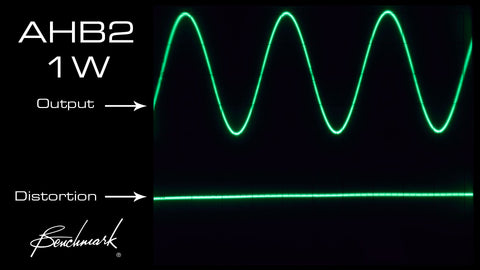
- Top trace is the output waveform.
- Bottom trace is distortion + noise
Note that there is no indication of crossover distortion.
Competing Class-AB amplifier at 1 W into 8 Ohms
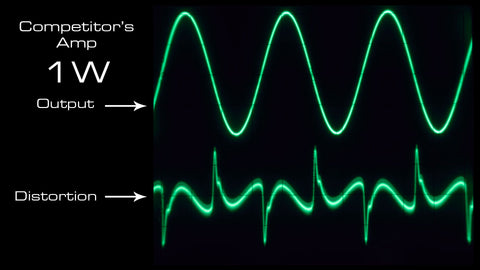
- Top trace is the output waveform.
- Bottom trace is distortion + noise
Note that crossover distortion is clearly visible as sharp transients in the distortion waveform. The transient shows a fast attack time followed by the recovery time of the feedback loop. This distortion waveform is typical of virtually all class-AB amplifiers.
AHB2 at 33 W into 8 Ohms
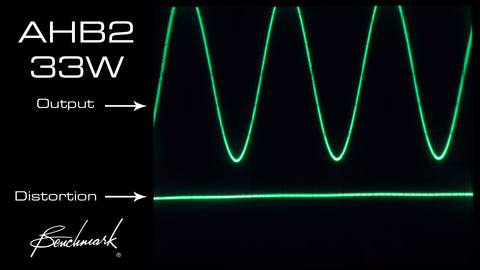
- Top trace is the output waveform.
- Bottom trace is distortion + noise
Competing Class-AB amplifier at 33 W into 8 Ohms
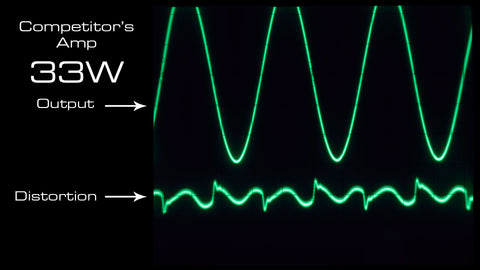
- Top trace is the output waveform.
- Bottom trace is distortion + noise
AHB2 at 100 W into 8 Ohms
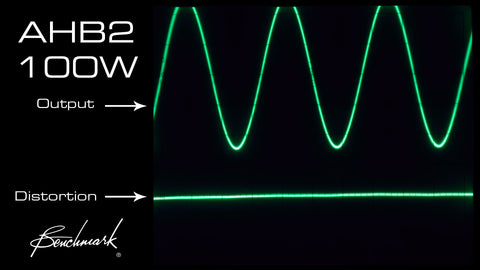
- Top trace is the output waveform.
- Bottom trace is distortion + noise
Competing Class-AB amplifier at 100 W into 8 Ohms
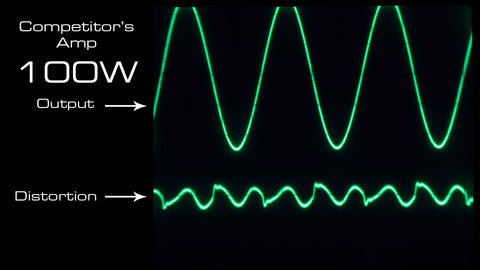
- Top trace is the output waveform.
- Bottom trace is distortion + noise
Also in Audio Application Notes

How Loud is the Distortion from Your Power Amplifier?
by John Siau August 08, 2025
Would you put a Washing Machine in your Listening Room?
If the answer is no, you may be surprised to discover that the distortion produced by your power amplifier may be louder than the noise produced by a major appliance.
Don't believe me? Take a look at Stereophile's test reports:
We selected 7 power amplifiers from Stereophile's top list of recommended amplifiers.
We took Stereophile's "THD+N vs. Power" plots for each, and replotted the data in a format that shows the loudness of the THD+N at the listening position.
The results are shocking!
Amplifier THD+N is louder than expected!
The distortion from your amplifier may be louder than a washing machine on the spin cycle, or it may be totally silent. How does yours perform? The answer is hidden in Stereophile's THD+N plots.
This application note reveals the hidden truth:
"The Distortion from your Power Amplifier may be Louder than a Washing Machine!"
I know, it sounds crazy, but this is what the measurements show!

Interpolator Overload Distortion
by John Siau November 20, 2024
Most digital playback devices include digital interpolators. These interpolators increase the sample rate of the incoming audio to improve the performance of the playback system. Interpolators are essential in oversampled sigma-delta D/A converters, and in sample rate converters. In general, interpolators have vastly improved the performance of audio D/A converters by eliminating the need for analog brick wall filters. Nevertheless, digital interpolators have brick wall digital filters that can produce unique distortion signatures when they are overloaded.
10% Distortion
An interpolator that performs wonderfully when tested with standard test tones, may overload severely when playing the inter-sample musical peaks that are captured on a typical CD. In our tests, we observed THD+N levels exceeding 10% while interpolator overloads were occurring. The highest levels were produced by devices that included ASRC sample rate converters.

Audiophile Snake Oil
by John Siau April 05, 2024
The Audiophile Wild West
Audiophiles live in the wild west. $495 will buy an "audiophile fuse" to replace the $1 generic fuse that came in your audio amplifier. $10,000 will buy a set of "audiophile speaker cables" to replace the $20 wires you purchased at the local hardware store. We are told that these $10,000 cables can be improved if we add a set of $300 "cable elevators" to dampen vibrations. You didn't even know that you needed elevators! And let's not forget to budget at least $200 for each of the "isolation platforms" we will need under our electronic components. Furthermore, it seems that any so-called "audiophile power cord" that costs less than $100, does not belong in a high-end system. And, if cost is no object, there are premium versions of each that can be purchased by the most discerning customers. A top-of-the line power cord could run $5000. One magazine claims that "the majority of listeners were able to hear the difference between a $5 power cable and a $5,000 power cord". Can you hear the difference? If not, are you really an audiophile?


